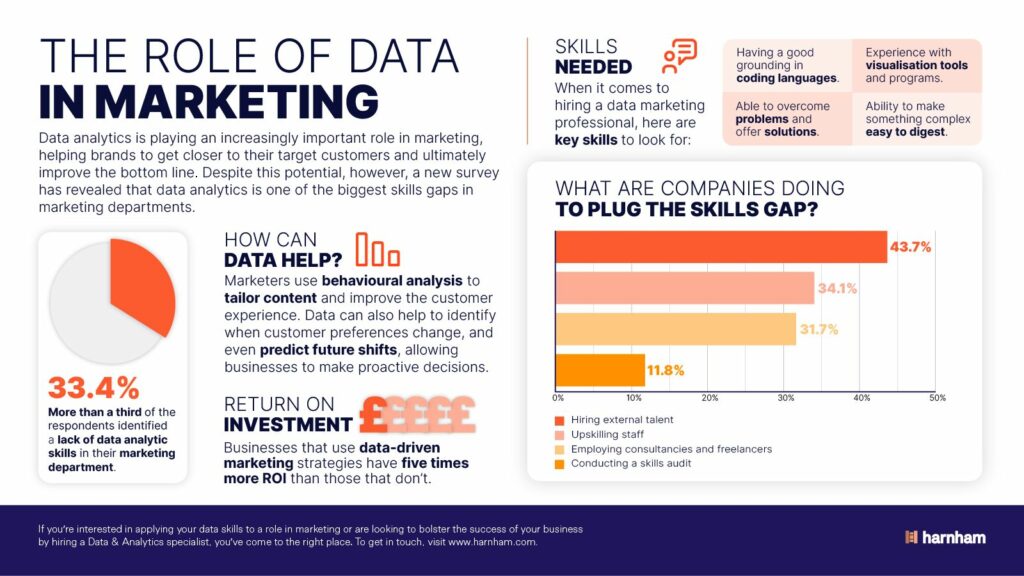Data can be leveraged in a myriad of ways and be beneficial to numerous business functions.
In marketing, for example, data is playing an increasingly important role in helping brands get closer to their target customers, which ultimately improves the bottom line. Businesses that use data-driven marketing strategies have five times more ROI than those that don’t.
Despite this potential, a new survey has revealed that data analytics is one of the biggest skills gaps in marketing departments. Below, we break down this new research and explain why it’s crucial to fill your company’s data skills gap and build a data-driven marketing team.

So why does this skills gap matter?
The recent research revealed more than a third (34.4%) of the 3,000-plus respondents identified a lack of data analytic skills in their marketing department. For B2B marketers, the figure drops to 29.9 per cent, while it’s 34.6 per cent for B2C marketers, and jumps to 39.6 per cent for businesses with a mix of both.
These findings are particularly pertinent as marketing isn’t a department that operates within a bubble, rather it has its tendrils in every part of an organisation, so when marketing isn’t functioning as optimally as possible, neither is the business.
Businesses that are not harnessing the insights that data analysis offers, are missing out on the ability to understand and meet their customer’s preferences. Making decisions that are not grounded in data means that a business is operating in the dark – throwing ideas at the wall to see what sticks rather than already knowing what will work because the data has told them so.
Many companies have realised that it’s no longer good enough to guess what customers might want or need from a product or service, but to instead have hard evidence to back up these choices. A data-led marketing strategy can revolutionise marketing efforts in numerous ways such as:
Behaviour analysis and personalisation
By analysing a customer’s behaviour, such as their e-commerce and website browsing habits, marketers can ensure that the businesses’ landing pages, calls to action and other marketing tools are working as they should be, and use this data to better tailor content and improve the customer experience.
Behaviour analysis might include examining customer interactions, such as where and when they click on a website, even down to which pages consumers are lingering on for longer. The content you are producing might be incredibly insightful and smart, but that’s irrelevant if customers aren’t reading it. Once you have understood where people do and don’t spend time and which content attracts the most engagement, assets can be shaped to scoop up people who might otherwise leave a site, further entice already interested parties and inform other marketing activities.
For example, if you’re a business that sells clothes, you can use data analytics to determine which colours and styles are most popular among your customers and create content such as fashion tips or trend reports including these colours and styles.
Through monitoring the current behaviour of customers, businesses can also more easily identify when and how their preferences change. For example, if visitors to written pieces are dropping off, you could consider incorporating more video content. Reacting to the subtle changes in customer behaviour can help companies to maintain their position in the market and increase their revenue by tapping into new pools of customers.
Predicting customer patterns
But data isn’t just for making better in-the-moment decisions. It can also help to pre-empt future customer behaviour, allowing businesses to make proactive decisions based on previous trends, rather than acting reactively.
Predictive analytics is the use of data algorithms and techniques to define the likelihood of future events or results, based on historical data from customer habits. It allows marketers to forecast a customer’s “next move”, such as which consumers are most likely to buy again, and therefore prioritise customers.
Based on previous patterns of behaviour, businesses can predict website engagement points where, for example, a customer may convert, but also areas where consumers might lose interest or drop off – friction points such as filling in a form. This information enables businesses to make choices that ensure that the customer experience is as smooth and effective as possible.
How can this skills gap be filled?
The effectiveness of data analysis is dependent on talent being able to carry it out. At Harnham, we specialise in data hires for marketing. In other words, through experience, our consultants have built a comprehensive picture of what marketing teams need when it comes to data marketing talent. When it comes to hiring a data marketing professional there are a wealth of skills to look for, including:
- Being a problem solver – a candidate who can identify logical ways to overcome problems and offer solutions.
- Having a good grounding in coding languages such as SQL. Whilst it can be beneficial to have more advanced modelling skills using R or Python, some companies will have data science teams to support on this side.
- Experience with visualisation tools and with programs such as Tableau or Looker – which can be hugely valuable in hitting the ground running.
Most crucial, however, is the ability to tell a story with the data and make something complex easy to digest. During an interview, businesses can identify how someone translates recommendations and if they are able to recognise and illustrate the commercial impact that their work will have.
If you’re interested in applying your data skills to a role in marketing or are looking to bolster the success of your business by hiring a Data & Analytics specialist, you’ve come to the right place contact our team today.

























